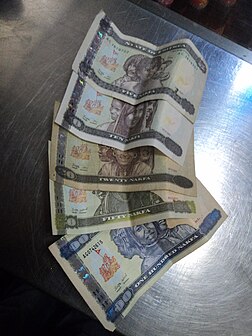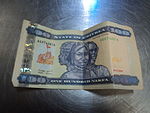 Nakfa banknotes | |
| ISO 4217 | |
| Code | ERN (numeric: 232) |
| Subunit | 0.01 |
| Unit | |
| Symbol | Nkf (Latin script) ናቕፋ (Ge'ez script) ناكفا (Arabic script) |
| Denominations | |
| Subunit | |
| 1⁄100 | cent |
| Banknotes | 1, 5, 10, 20, 50, 100 nakfa |
| Coins | 1, 5, 10, 25, 50 cents, 1 nakfa |
| Demographics | |
| Date of introduction | 15 November 1997 |
| User(s) | |
| Issuance | |
| Central bank | Bank of Eritrea |
| Valuation | |
| Inflation | 9% |
| Source | April 2017[1] |
| Pegged with | U.S. dollar = 15 nakfa |
The nakfa (ISO 4217 code: ERN; Tigrinya: ናቕፋ naḳfa, or Arabic: ناكفا or نقفة nākfā) is the currency of Eritrea and was introduced on 15 November 1997 to replace the Ethiopian birr at par. The currency takes its name from the Eritrean town of Nakfa, site of the first major victory of the Eritrean War of Independence. The nakfa is divided into 100 cents.
The nakfa is pegged to the US dollar at a fixed rate of US$1 = ERN 15. At earlier times,[when?] it was officially pegged at US$1 = ERN 13.50. The currency is not fully convertible, so black market rates available on the streets typically offered a rate of 15 nakfas per dollar.[2][needs update]
Between 18 November and 31 December 2015, the Bank of Eritrea began replacement of all nakfa banknotes. The banknote replacement initiative was designed to combat counterfeiting, the informal economy but primarily Sudanese human traffickers who had accepted payments in nakfa banknotes in exchange for transporting would-be migrants primarily to Europe. A consequence of this was substantial amounts of the country's currency existed in vast hoards outside of Eritrea.
The plan to replace the country's currency was top secret and designed to prevent human traffickers bringing their funds back in time to exchange for the new banknotes.[3] On 1 January 2016 the old nakfa banknotes ceased being recognized as legal tender, rendering external stockpiles of currency worthless.[4]
The current series of banknotes is the artwork of an Afro-American banknote designer, Clarence Holbert,[5] and printed by German currency printer Giesecke & Devrient.[6]
Nakfa coins are made entirely of nickel-clad steel. Each coin has a different reeded edge, instead of consistent reeding for all denominations. The 1 nakfa coin carries the denomination "100 cents". The common reverse shows fighters raising the Eritrean flag, the date "1991" and the legend "Liberty, Equality and Justice."[7]
| Image | Value | Obverse design |
|---|---|---|
| [1] | 1 cent | Red-fronted gazelle[8] |
| [2] | 5 cents | Leopard |
| [3] | 10 cents | North African ostrich |
| [4] | 25 cents | Grévy's zebra |
| [5] | 50 cents | Greater kudu[9] |
| [6] | 100 cents | African bush elephant and calf |
The nakfa banknotes were designed by Clarence Holbert of the United States Bureau of Engraving and Printing in 1994. They depict ordinary people from each of Eritrea's nine principal ethnic groups (Tigrinya, Tigre, Rashaida, Nara, Afar, Saho, Bilen, Beja, Kunama), rather than any political or historical figures.

There have been five series of banknotes since the currency's launch. The first issue for all denominations was dated 24.5.1997; the second issue consists of only the 50 and 100 nakfa notes and is dated 24.5.2004; the third issues also consists of only the 50 and 100 nakfa notes and was dated 24.5.2011, and the fourth issues consisted of only the 10 and 20 nakfa notes and was dated 24.5.2012. (May 24 is Eritrea's Independence Day).[10] The current fifth banknote series which rendered all previous currency valueless is dated 24.5.2015.
| Banknotes of the Eritrean nakfa (1997–present series) | ||||||||
|---|---|---|---|---|---|---|---|---|
| Image | Value | Dimensions | Main Color | Description | Date of issue | Date of first issue | Watermark | |
| Obverse | Reverse | |||||||
 
|
1 nakfa | 140 x 70 mm | Dark brown and black on multicolored underprint | Triple portrait of three children of Eritrea's nine nationalities; flag raising | Children in bush school | 1997 2015 |
May 24, 1997 | Camel head |
 
|
5 nakfa | 140 x 70 mm | Dark brown and black on multicolored underprint | Triple portrait of Eritrea's nine nationalities: Young boy, young man, and older man; flag raising | Sycamore fig tree | 1997 2015 |
May 24, 1997 | Camel head |
 
|
10 nakfa | 140 x 70 mm | Dark brown and black on multicolored underprint | Triple portrait of three young women of Eritrea's nine nationalities; flag raising | Eritrean railway | 1997 2012 2015 |
May 24, 1997 | Camel head |

|
20 nakfa | 140 x 70 mm | Dark brown and black on multicolored underprint | Triple portrait of three young women of Eritrea's nine nationalities; flag raising | Three agricultural scenes: farmer plowing with a camel, women harvesting, woman on tractor | 1997 2012 2015 |
May 24, 1997 | Camel head |

|
50 nakfa | 143 x 71 mm | Brown-red on pale yellow underprint | Triple portrait of three women of Eritrea's nine nationalities; flag raising | Freighter ships at Massawa port | 1997 2004 2011 2015 |
May 24, 1997 | Camel head |

|
100 nakfa | 147 x 72 mm | Blue and black on pale yellow underprint | Triple portrait of three women of Eritrea's nine nationalities; flag raising | Farmers plowing with oxen | 1997 2004 2011 |
May 24, 1997 | Camel head |
| Current ERN exchange rates | |
|---|---|
| From Google Finance: | AUD CAD CHF CNY EUR GBP HKD JPY USD ETB |
| From Yahoo! Finance: | AUD CAD CHF CNY EUR GBP HKD JPY USD ETB |
| From XE.com: | AUD CAD CHF CNY EUR GBP HKD JPY USD ETB |
| From OANDA: | AUD CAD CHF CNY EUR GBP HKD JPY USD ETB |
Eritrea's government has resisted calls to float the nation's currency, preferring the stability of a fixed exchange rate. However periodic devaluations have been made. ERN is a very weak currency. The de facto exchange rate of the currency is around 100 ERN for US$1.[citation needed] The currency does not have a good demand outside of Eritrea. The black markets that exist in Asmara and a few other towns show the diminishing values of ERN.